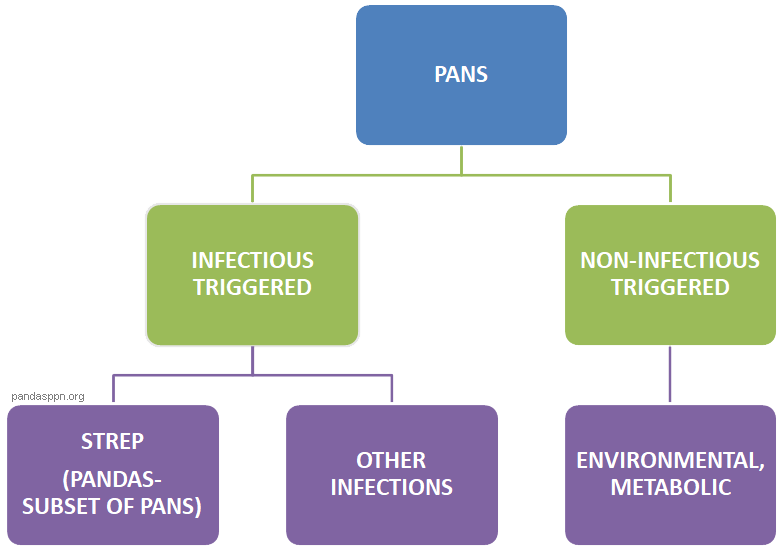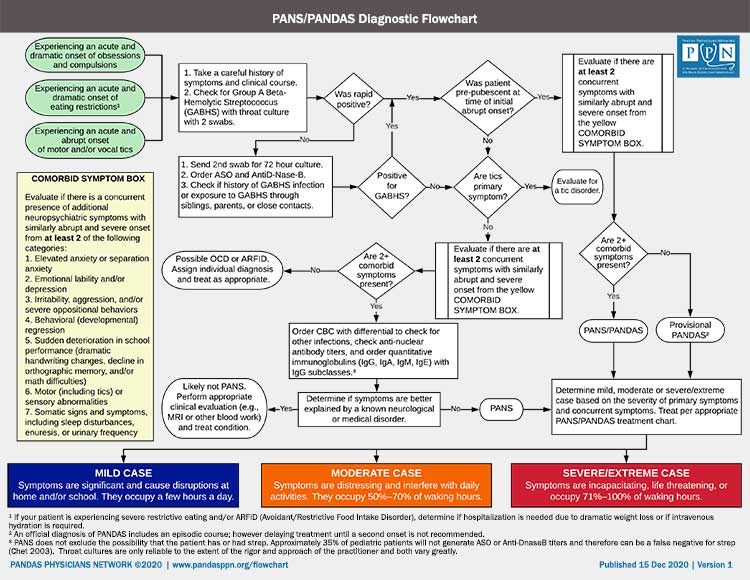WHAT IS PANS/PANDAS?
WHAT IS PANS?
PANS (“Pediatric Acute-onset Neuropsychiatric Syndrome”) is a clinically defined disorder characterized by the sudden onset of obsessive-compulsive symptoms (OCD) or eating restrictions, concomitant with acute behavioral deterioration in at least two designated domains. Comorbid PANS symptoms may include: anxiety, sensory amplification or motor abnormalities, behavioral regression, deterioration in school performance, mood disorder, urinary symptoms and/or sleep disturbances.
PANS does not require a known trigger, although it is believed to be triggered by one or more pathogens.
WHAT IS PANDAS?
PANDAS (“Pediatric Autoimmune Neuropsychiatric Disorders Associated with Streptococcal Infections”) is a subset of PANS and was first reported by a team at the National Institute of Mental Health (part of NIH) in 1998. PANDAS has 5 distinct criteria for diagnosis, including abrupt “overnight” OCD or dramatic, disabling tics; a relapsing-remitting, episodic symptom course; young age at onset (average of 6–7 years); presence of neurologic abnormalities; and temporal association between symptom onset and Group A strep (GAS) infection. The 5 criteria usually are accompanied by similar comorbid symptoms as found in PANS.
Is PANS PANDAS Autoimmune/Autoinflammatory?
Autoimmune or Autoinflammatory Disease – Researchers hypothesize that simultaneous exposure to multiple infectious organisms can (i) override the natural immunological mechanisms which prevent the immune system from attacking self-antigen; and/or (ii) produce abnormal activation of the immune system, which then attacks neuronal cells. It is also possible that some people are genetically predisposed to these forms of dysregulated immune response.
Why do some children get PANDAS after a Group A strep infection while others do not?
Science has not yet answered this question. Possible hypotheses include the following:
Strain Differences
There are over 150 strains of Group A streptococci (GAS) and only 10–12 of these cause acute rheumatic fever and Sydenham chorea, the medical model of PANDAS. It is reasonable to hypothesize that only certain strains of GAS trigger symptoms of PANDAS. Geographic clusters of new cases of PANDAS have been reported, which would give credence to this possibility.
Genetic Vulnerability
Defects in clearing Group A strep, resolving inflammation after group A strep, differences in neurocircuitry, cytokine receptors in the brain, or abnormal expression of neurosignaling molecules/receptors during infection are all hypothesized to play a role in neuroimmune disorders including PANS and PANDAS. No genetic marker has been determined as of today.
Location of Strep Infection
Strep infections typically occur in the oropharynx, tonsils, and anus, and each area should be examined and swabbed for culture. Although “strep throat” infections are the most common trigger, PANDAS has been reported to occur in association with perianal strep infections. Additional sites may be involved; for example, animal research suggests that strep in the nasal cavity may enter or influence neuroimmune cells along the olfactory nerve, providing access to the brain through the third ventricle.
Can a patient have PANDAS without having evidence of strep?
Yes, although documentation of a preceding strep infection is required to meet the criteria for PANDAS, cases in the community are often diagnosed on the basis of a history of exposure to known GAS infection (particularly in a sibling or overnight stay with a friend/relative). The strep bacteria which produce post-infectious sequelae, such as PANDAS, are often not symptomatic for pharyngitis; they produce minimal or no symptoms of sore throat, fever, abdominal pain, etc, so the infections go undetected and untreated for prolonged periods of time. Documenting a strep trigger may also be difficult because of the lag between the inciting infection and symptom onset (3–9 months in the case of Sydenham chorea).
Additional issues in locating the strep trigger include:
► Commercial serologic tests miss at least one-third of GAS infections; the ASO and anti-DNase B tests have a false negative rate of 37%. (In a 2003 study, children with GAS pharyngitis and positive throat cultures failed to produce anti-DNase B antibodies or ASO antibodies approximately 37% of the time.)
► GAS cultures can be difficult to obtain, and one must adequately swab the affected areas.
► GAS may reside in tonsillar crypts and may not be detected using routine throat swab.
► Rapid strep tests miss 15%-20% of infections, so overnight (or 48-hour) cultures must be done.
PANDAS is the only subtype of PANS that requires that symptoms be associated with a strep infection. PANS has been reported to occur in association with a variety of infectious agents, including influenza, varicella, and mycoplasma pneumoniae. Lyme disease has also been proposed as a trigger of neuropsychiatric symptoms, including those meeting criteria for PANS.

Diagnostic and Treatment Flowcharts
The PANDAS Physicians Network (PPN) flowcharts for diagnosis and treatment will help clinicians determine the appropriate diagnosis and symptom severity based treatment protocols for mild, moderate, and severe/extreme cases of PANS PANDAS. Access the flowcharts at https://www.pandasppn.org/flowchart/.






